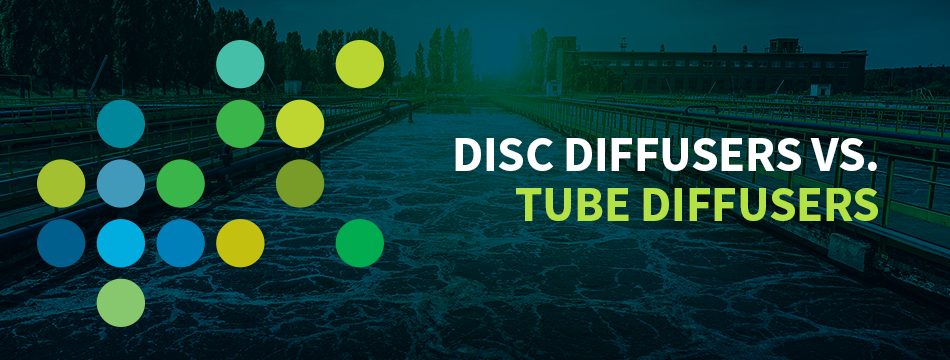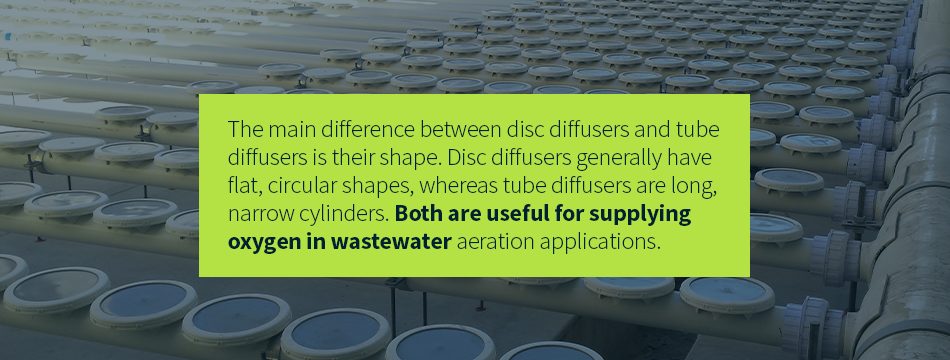Disc Diffusers vs. Tube Diffusers
By: Tom Frankel
Post Date: July 24th 2020

Table Of Contents
- WHAT IS THE DIFFERENCE BETWEEN DISC DIFFUSERS AND TUBE DIFFUSERS?
- Pros of Disc Diffusers
- Cons of Disc Diffusers
- Pros of Tube Diffusers
- Cons of Tube Diffusers
- HOW TO CHOOSE THE RIGHT DIFFUSER FOR YOUR AERATION SYSTEM
In wastewater aeration systems, fine bubble diffusers are known for their incredible oxygen transfer efficiency and their energy consumption savings. They can reduce aeration energy consumption by 25% to 75% — and coarse bubble diffusers are renowned for their mixing power.
Aeration diffusers come in a few different styles — two popular ones are tube diffusers and disc diffusers. In this guide, we’ll discuss what the pros and cons of tube diffusers and disc diffusers are and how plants can choose the best fit for their wastewater applications.
What Is the Difference Between Disc Diffusers and Tube Diffusers?
The main difference between disc diffusers and tube diffusers is their shape. Disc diffusers generally have flat, circular shapes, whereas tube diffusers are long, narrow cylinders. Both are useful for supplying oxygen in wastewater aeration applications.
Disc Diffusers
How do disc diffusers work, and what are some of the benefits of disc diffuser aeration systems?
Disc diffusers, especially 9-inch fine bubble disc diffusers, are extremely common in the wastewater treatment industry. They typically consist of disc-shaped ceramic, plastic or EPDM rubber membranes attached to a system of pipes and blowers. The blowers send air through the pipes, and the air flows out in bubbles through tiny slits or pores in the diffuser membranes. The bubbles then aerate the wastewater by transferring oxygen to the water column.
Diffusers may have additional protective coatings such as PTFE, PEEK,or Viton® coatings to help protect against fouling.
Pros of Disc Diffusers
Some of the advantages of disc diffusers include the following:
- Minimal maintenance needs: Disc diffusers require relatively little maintenance. They are useful in tanks where diffusers are more challenging to repair and replace.
- Increased longevity: Disc diffusers have relatively long lifespans. They are also useful in tanks where diffuser replacement would be a costly and time-consuming undertaking.
- Slower failure rates: Because disc diffusers typically have smaller holes than tube diffusers, they have slower failure rates. If one orifice becomes cracked, it will leak air at a slower rate than a larger orifice and cause less compromise to the system overall.
- Higher oxygen transfer efficiency: Because disc diffusers often produce smaller bubbles, they offer a greater bubble surface area for oxygen transfer.
- All-purpose compatibility: Though they have their strengths and weaknesses with different systems, overall, discs are excellent as all-purpose wastewater diffusers.
Cons of Disc Diffusers
Some of the disadvantages of disc diffusers include the following:
- Requires a larger area: Disc diffuser arrays are not as compact as tube diffuser arrays, so it is difficult to pack as many diffusers into a small tank.
- Costs more: Disc diffuser layouts often cost more than tube diffuser layouts, especially in configurations that require expensive stainless steel.
- Has a higher buoyancy: The flat shape of disc diffusers makes them more buoyant than tube diffusers. This buoyancy may cause unwanted motion in the diffuser system.
- Requires more labor time: Disc diffuser systems require more stainless steel than tube diffuser systems. In configurations that require stainless steel, disc diffuser systems can sometimes take longer to install. However, using options like PODsTM disc diffusers, which consist of discs pre-mounted on pipe, can help overcome this disadvantage.
- Offers fewer mixing capabilities: Because disc diffusers tend to produce smaller bubbles, they offer less power for mixing. However, the use of a coarse-bubble disc diffuser like SSI’s ReliaBallTM can help minimize this disadvantage.
Uses for Disc Diffusers
Disc diffusers are particularly ideal for use in the following scenarios:
- Shallow tanks: The tremendous oxygen transfer efficiency of disc diffusers’ small bubbles makes them advantageous for shallow tanks, where vigorous mixing is less of a necessity.
- Fixed systems: Disc diffusers are popular in fixed systems. Bolting pipes permanently to the floor helps reduce the disadvantages of buoyancy and allows wastewater treatment facilities to take advantage of disc diffusers’ benefits. The longevity and minimal maintenance requirements of disc diffusers are also essential in fixed systems, where plants cannot remove the diffusers for repairs.
ASK AN EXPERTCALL US AT (845) 454-8171REQUEST A QUOTE

Tube Diffusers
How do tube diffusers work, and what are some of the benefits of tube diffuser aeration systems?
Tube diffusers work very similarly to disc diffusers. They typically consist of long, cylindrical membranes that attach to pipe and blower systems to assist with wastewater aeration. They may also make use of protective coatings to reduce fouling.
Pros of Tube Diffusers
Some of the advantages of tube diffusers include the following:
- Improved design: Because they are so slender, many tube diffusers can fit into a tank with a relatively modest footprint.
- Increased mixing capabilities: Many tube diffusers tend to produce relatively large bubbles. The large bubbles often produced with tube diffusers offer superior mixing capabilities.
- Lower cost: Tube diffusers are an excellent option for cost-conscious consumers. Reduced stainless steel use is a large part of the reason — stainless steel is expensive, whereas plastic and rubber are more economical.
- Neutral buoyancy: Tube diffusers are neutrally buoyant. This characteristic gives them an advantage in certain aerator layouts.
- Reduced labor time: The reduced quantity of stainless steel needed for tube diffusers leads to reduced labor time and quicker delivery of tube diffuser grids. This feature makes tube diffusers an attractive option when a quick turnaround time from design to installation is essential.
Cons of Tube Diffusers
Some of the disadvantages of tube diffusers include the following:
- Higher maintenance needs: Tube diffusers typically require higher levels of maintenance than disc diffusers, though using membranes with a protective coating like PTFE can help reduce maintenance requirements.
- Shorter lifespans: Tube diffusers tend not to last as long as disc diffusers, though using membranes with a protective coating can help tube diffusers last longer, as well.
- Higher likelihood of catastrophic failure: Because tube diffusers have larger orifices than disc diffusers, the likelihood of catastrophic failure increases. If an orifice cracks, the large opening could leak enormous amounts of oxygen. However, the use of fine-bubble tube diffusers can help decrease this risk.
- Less oxygen transfer efficiency: The larger bubbles often produced from tube diffusers lead to reduced oxygen transfer efficiency. However, the use of fine-bubble tube diffusers can help diminish this disadvantage.
- Minimal benefits with fixed systems and shallow tanks: Tube diffusers don’t offer particular benefits for fixed systems or shallow tanks, though they have strengths for other systems.
Uses of Tube Diffusers
Tube diffusers are particularly useful in the following scenarios:
- Deep tanks or tanks with high solid content: The superior mixing capabilities of tube diffusers make them ideal for larger tanks or wastewater with a high biosolid composition.
- Narrow tanks: In tanks with small footprints, it’s difficult to fit as many disc diffusers. But slender tube diffusers offer a compact fit to provide efficiency and power in a small space.
- Retrievable grids: What type of diffuser is best for a retrievable grid system? Though some retrievable grids use disc diffusers, most of them use tube diffusers. The neutral buoyancy of tube diffusers makes them valuable in this case — the buoyancy of disc diffusers can cause them to bounce or “dance” in the tank because the grid is not permanently secured. Ballast weight can help, but using tube diffusers helps avoid the extra time and cost of installing it — and retrievable grids typically require sturdy stainless steel, which makes tube diffusers a natural choice.
How to Choose the Right Diffuser for Your Aeration System
Should you use disc or tube diffusers for wastewater treatment? When you’re considering disc or tube diffusers, determine the highest priorities for your plant. If low maintenance and a long lifespan are a priority and you have shallower tanks or plan to use fixed systems, disc diffusers may be the best option. Alternatively, if you plan to use retrievable systems or have deeper, narrower tanks, tube diffusers may provide more benefits.
SSI Aeration: Worldwide Provider of Disc and Tube Diffusers
Whether you need disc diffusers or tube diffusers for your wastewater aeration system, let SSI Aeration be your trusted source. Our experienced engineering teams and industry-leading technology make our diffuser systems some of the best in the business — including our PODs preassembled disc diffuser system, which allows for quick and easy installation.
Contact us today to learn more.

ASK AN EXPERTCALL US AT (845) 454-8171REQUEST A QUOTE

Mr. Frankel co-founded SSI in 1995 with experience in design and distribution of engineered systems. He is in charge of sales, marketing and operations in the company. Mr. Frankel holds multiple US patents related to diffusers. He is a graduate of Washington University in St. Louis.

